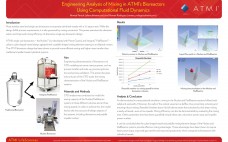Hydrolysates are complex media supplements composed of many as well as different types of components. Predicting cell culture performance of a particular lot remains an elusive target, other than by small scale cell culture testing which consumes valuable time, effort and resources. In order to reduce the need for incoming acceptance tests by our customers, FrieslandCampina Domo plans to develop a simple analytical assay that accurately predicts cell culture performance. Our Quality by Design project has provided information at the…
Expression Platforms
Effect of process condition on the Mycoplasma rentention of cell culture media filtersMethods
A Mycoplasma contamination event can have a major impact on a biopharmaceutical manufacturer. The loss of a cell culture due to a contamination incurs significant costs that can be attributed to both the initial bioreactor set-up and to the subsequent decontamination. Production facility throughput may be affected and in the worst cases the ability of the manufacturer to supply patients with medicines. Mycoplasma are extremely small in size and lack a cell wall giving the cells some flexibility that enables…
Trends and New Technology in Vaccine Manufacturing
Significant changes are sweeping the vaccine manufacturing industry. Demand for human vaccines is predicted to grow significantly — in part driven by needs in emerging countries, where only small fractions of their large and growing populations has access to vaccines. Sustained growth is expected to yield a vaccine market of US$25 billion by the year 2015 (1). Relatively low immunization rates in the Asia–Pacific regions represent significant untapped potential for vaccine manufacturers. Growing populations, increased government funding, and increasing personal…
Pseudomonas fluorescens Expression Technology for Subunit Vaccine Production and Development
New methods and platforms for rapid development and production of effective subunit vaccines have become a 21st-century imperative. Not only is it important to rapidly express and produce a large number of antigens, but those antigens must be expressed and folded such that their effectiveness in preclinical studies is predictive of their potential effectiveness as vaccines. This task has created a bottleneck in vaccine development because recombinant protein expression is difficult and time-consuming, involving a large number of variables. Highly…
New Plant Expression Systems Drive Vaccine Innovation and Opportunity
Plant expression systems are emerging as fast and inexpensive methods for producing vaccines. Someday, plants may surpass mammalian and even many microbial systems in efficiency and cost-benefits for the manufacture recombinant proteins. This is particularly so for the rapid manufacture of truly large-scale (million- or even billion-dose) vaccine antigens. Whether grown as single cells or tissues in photosynthesis reactors, as whole plants in controlled laboratory situations, or cultivated in fields of transformed food-commodity plants (e.g., rice, potatoes, or tobacco), plants…
Engineering Analysis of Mixing in ATMI’s Bioreactors Using Computational Fluid Dynamics
The Integrity® PadReactor™ and Nucleo™ systems are a single-use bioreactors specifically designed to fulfill the needs of cell culturists. They are perfectly suited to laboratory environments, process develop¬ment centers, clinical material supply and flexible GMP manufacturing. The bioreactor vessel, which offers comparable functionality to classical stirred tank bioreactors, is a single-use bag integrating an internal paddle mixing and sparger system. This innovative bag design allows a non-invasive connection to the system. The paddle is enclosed in a medical grade ULDPE…
Viral Vaccine Manufacturing Scale Using the iCELLIstm Disposable Fixed-Bed Reactor
Viral vaccines are usually produced by anchorage-dependent cell lines. At industrial scale, these cells are either cultivated in static mode on multiplate systems (Roller bottles, Cell Factories, Cell Cube, etc.) or on suspended micro-carriers (porous or non-porous) in in bioreactors. Multiplate systems are bulky and require a lot of handling operations, whereas microcarrier cultures require numerous operations (sterilization and hydration of carriers,bead-to-bead transfers) from pr eculture to final process. However most of the currently available disposable reactors are not well…
Cell Culture Design Space Modeling using a Scale-Down Approach
As an industry initiative to “provide assurance of quality,” the ICH Q8 guideline proposes building quality into the design of experiments by defining the process design space within which critical product quality attributes are within an acceptable range. A characterized design space not only enhances process knowledge but also can later be utilized for process validation and regulatory filings, saving on the time and cost of additional filings if process changes are implemented in the future. Because it is neither…
Performance of the BioScale ViBE Protein Analysis Workstation Host Cell Protein Assay
Measurement of host cell protein (HCP) contaminants is essential for developing and monitoring an effective purification process for recombinant proteins. Of the multiple techniques available to quantify the concentrations of these contaminants, the most popular format uses polyclonal antisera in a sandwich ELISA. The purpose of this work is to evaluate the performance of a newly emerging technology; the BioScale ViBE™ Platform. Using an assortment of bioprocess samples selected from multiple stages of the purification process, ViBE Workstation performance was…
Changes in Media Composition due to Expression of IgG in HEK293 and CHO DG44 Cells
Quality of recombinant/therapeutic proteins produced by engineered cell lines is a concern shared by both manufacturers and regulatory agencies. New assays are needed to facilitate earlier and more rapid analysis of therapeutic protein quality. Cell culture supernatant contains secreted proteins that are indicative of the cellular condition and thus are potential indicators of recombinant protein quality. This study identified changes in secreted host cell proteins (HCP) from cell pools exhibiting varying levels of recombinant antibody expression as determined by quantitative…







